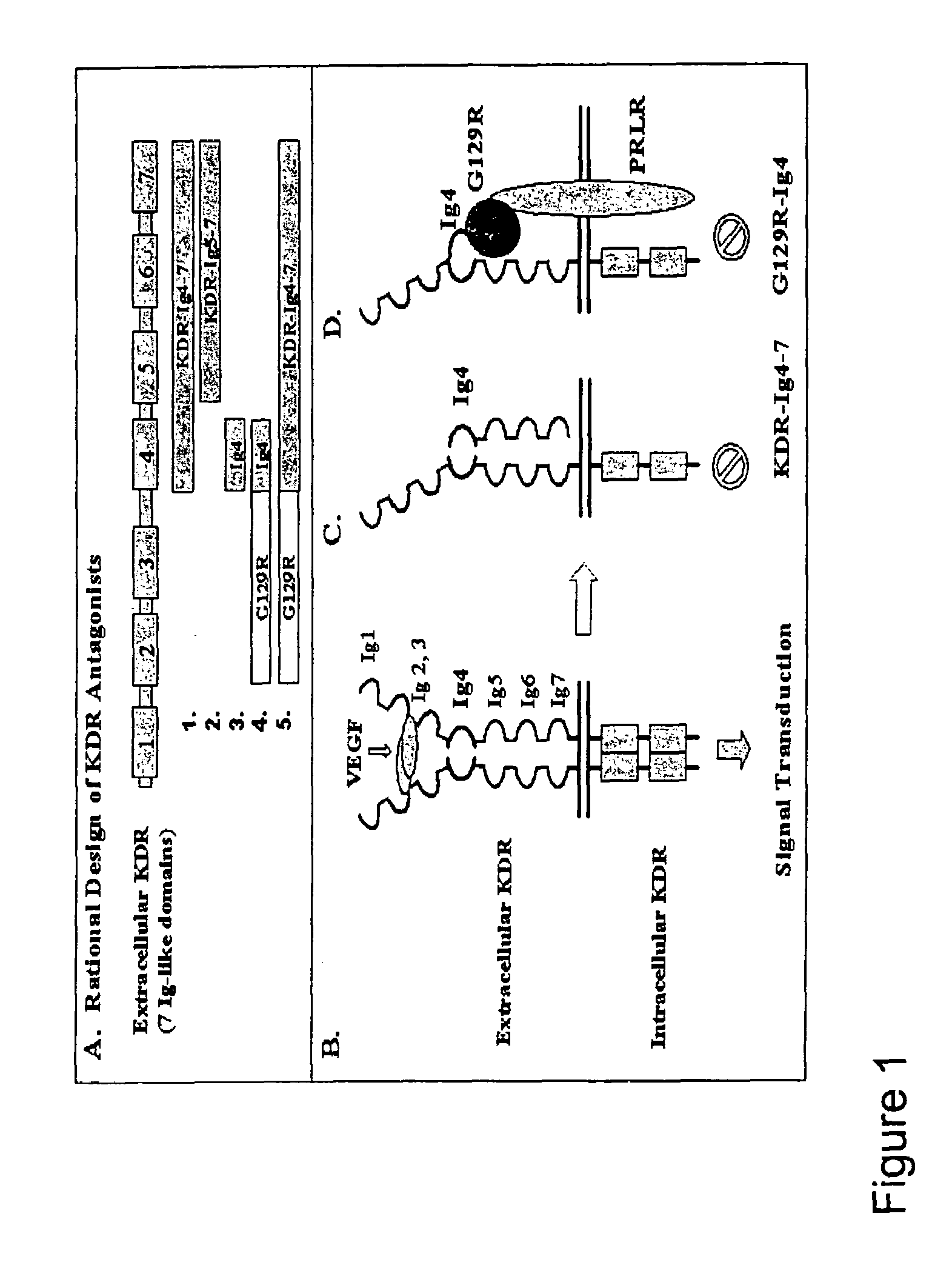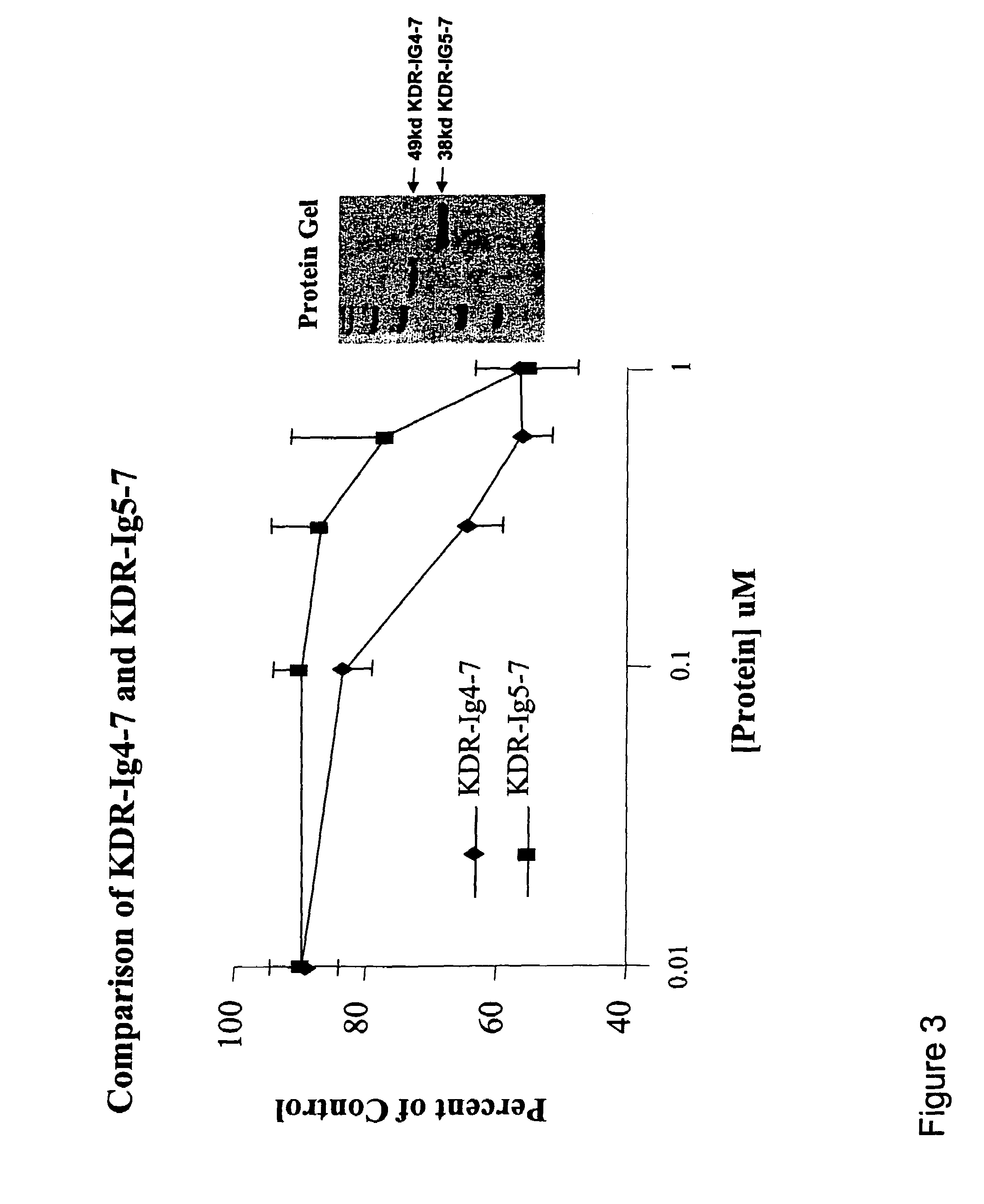VEGF receptor antagonists
a technology of vascular endothelial growth factor and receptor antagonist, which is applied in the field of cancer therapy and angiogenesis inhibitors, can solve the problems of kdr dimerization and activation, and achieve the effect of slowing the progression of cancer and slowing cell proliferation
- Summary
- Abstract
- Description
- Claims
- Application Information
AI Technical Summary
Benefits of technology
Problems solved by technology
Method used
Image
Examples
example 1
Production and Purification KDR Receptor Antagonists
[0115]Three recombinant proteins (KDR (Ig4), KDR (Ig5-7) and KDR (Ig4-7)) were produced and purified. Recombinant proteins of the present invention can be produced from E. coli. according to published protocols (Cataldo et al., Int. J. Oncol. 17:1179-85 (2000)) with modifications.
[0116]Briefly, BL21 (DE3) cells (Novagen, Madison, Wis.) were transformed with plasmids encoding recombinant proteins using a calcium chloride method. The transformants were spread on an ampicillin plate, and grown overnight at 37° C. The LB seed culture was inoculated and grown overnight. The following day a LB growth culture was generated by inoculation of 5% of the seed culture and grown for ˜2.5 hours at 37° C. with agitation. IPTG (Fisher Scientific) was added to the culture (1 mM final concentration) to induce expression of recombinant proteins and incubated for an additional 4 hours. Bacteria was pelleted and resuspended in a solution containing 0.2...
example 2
KDR (Ig4-7) Inhibited MAPK Phosphorylation in T-47D Human Breast Cancer Cells
[0117]T-47D cells were cultured overnight in serum free media at 80% confluency and were treated for 60 minutes with G129R (10 μg / ml, ˜0.5 μM); hPRL (100 ng / ml, ˜5.0 nM), and KDR (Ig4-7) (25 μg / ml, ˜0.5 μM) as compared to untreated cells (basal). Membranes were stripped and re-probed with anti-MAPK antibody to ensure equal loading. Results indicate that MAPK phosphorylation decreased in the presence of KDR (Ig4-7) compared to control samples. Thus, KDR (Ig4-7) blocks the ability of a full length KDR monomer to form a functional homodimer and effect VEGF signaling (FIG. 5).
example 3
KDR (Ig4-7) and KDR (Ig5-7) Decreased Cell Proliferation in a Breast Cancer Cell Line
[0118]The cell proliferation assay was performed according to Beck et al. (2003) (supra). MDA-MB 231 or T-47D cells (which are KDR positive cell lines) were grown in medium free of phenol-red. Fully confluent MDA-MB 231 and T-47D cell cultures were trypsinized and resuspended in a medium containing 5% fetal bovine serum (FBS). Cells were then seeded into 96-well culture plates at a density of 15,000 MDA-MB 231 cells / well or 15,000T-47D cells / well. After incubating the cells for 24 hours, various concentrations of tester proteins were added to the wells. Cells were further incubated for 48-72 hours at 37° C. in a humidified 5% CO2 incubator. The viability of the cells was determined using the MTS-PMS (CellTiter 96 Aqueous Kit; Promega Corp., Madison, Wis.) colorimetric assay according to the manufacturer's protocol. Absorbance at 490 nm was determined using a microplate reader (BioRad).
[0119]Results ...
PUM
| Property | Measurement | Unit |
|---|---|---|
| pH | aaaaa | aaaaa |
| soluble | aaaaa | aaaaa |
| affinity | aaaaa | aaaaa |
Abstract
Description
Claims
Application Information
 Login to View More
Login to View More - R&D
- Intellectual Property
- Life Sciences
- Materials
- Tech Scout
- Unparalleled Data Quality
- Higher Quality Content
- 60% Fewer Hallucinations
Browse by: Latest US Patents, China's latest patents, Technical Efficacy Thesaurus, Application Domain, Technology Topic, Popular Technical Reports.
© 2025 PatSnap. All rights reserved.Legal|Privacy policy|Modern Slavery Act Transparency Statement|Sitemap|About US| Contact US: help@patsnap.com



